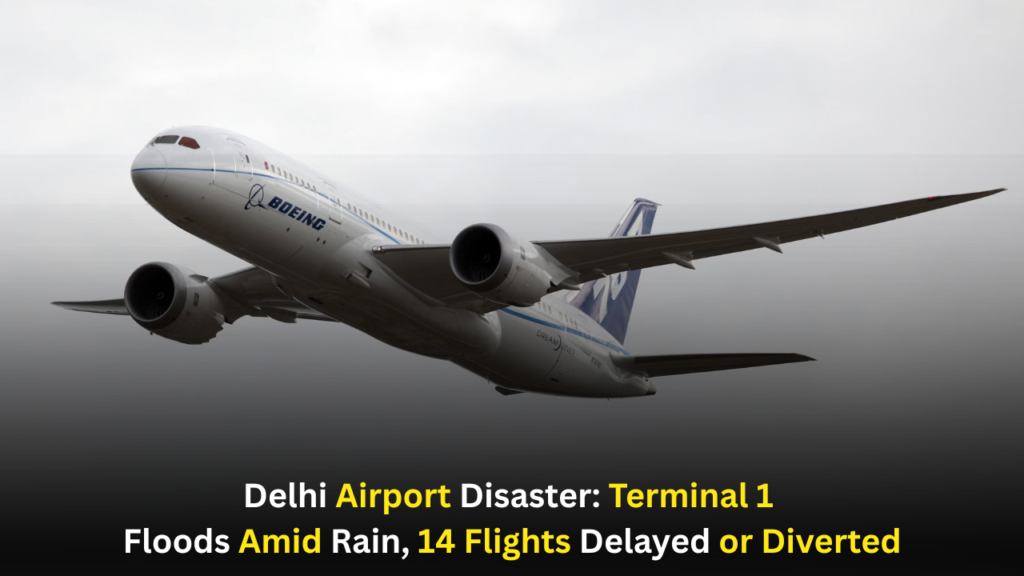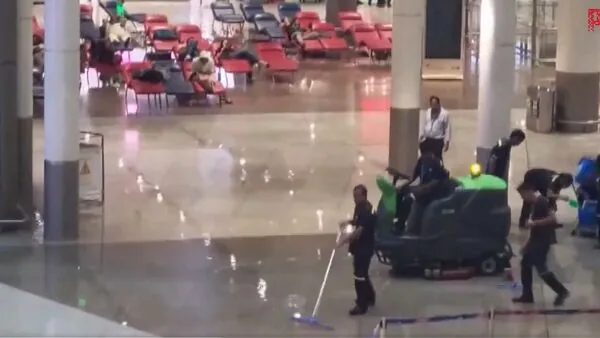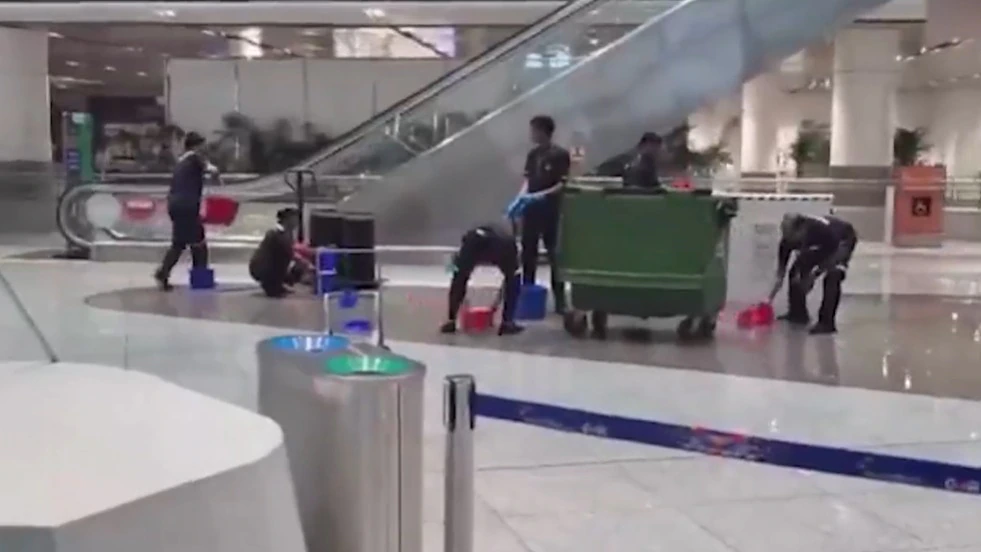
Monsoon
1.  Intro – Monsoon Arrives with a Bang in Delhi-NCR
Intro – Monsoon Arrives with a Bang in Delhi-NCR
On June 17, 2025, Delhi-NCR experienced unexpected heavy rainfall and thunderstorms—bringing both relief from intense summer heat and sudden disruptions across transportation networks. The downpour triggered flash flooding on roads, led to widespread waterlogging, and impacted airline operations at Indira Gandhi International Airport. Most strikingly, Terminal 1 saw rainwater pouring through the ceiling and inundating the food court, prompting staff to clear puddles with buckets and mops—all while more than 14 flights were diverted or delayed due to adverse weather conditions.
2.  Weather Event Breakdown: What Exactly Happened?
Weather Event Breakdown: What Exactly Happened?
- Two Rain Spells, Strong Winds: The India Meteorological Department (IMD) reported two distinct showers—first in early afternoon, followed by intense evening squalls, fueled by moisture from the Bay of Bengal and a western disturbance. Rainfall ranged from 14 mm at Lodhi Road to a peak of 57 mm at Pusa between 2:30–8:30 pm. Wind speeds reached up to 43 km/h, with areas like Mayur Vihar experiencing gusts of 50–70 km/h.
- Temperature Drop & Monsoon Advance: Temperatures dropped sharply from ~36°C to ~27°C, offering much-needed relief. IMD later issued a yellow alert for continued rain and thunderstorms on June 18, signaling a likely early arrival of the monsoon in Delhi.

3.  Airport Disruption: Flight Diversions, Delays & Safety Hazards
Airport Disruption: Flight Diversions, Delays & Safety Hazards
- 14 Flights Diverted: Adverse weather forced airlines to reroute at least 14 flights between 1–5 pm. Operations were disrupted as aircraft avoided unsafe landing conditions.
- Operational Delays & Safety Measures: Hundreds of flights were delayed (average ~65 minutes). Despite flooding, airport services remained active. Authorities advised travelers to arrive early and check flight status due to possible rescheduling.
4.  Terminal 1 Flooding: Visuals and Infrastructure Strain
Terminal 1 Flooding: Visuals and Infrastructure Strain
- Water seeping into Terminal 1: Staff were seen using buckets and mops to remove water from the newly opened food court—prompt action contained the issue within 30 minutes.
- Weak links exposed: Overflowing rooftop drains and malfunctioning pumps in underpasses, especially the Zakhira underpass, highlighted infrastructural weaknesses in drainage systems.
5.  City-Wide Disruptions: Waterlogging & Traffic Snarls
City-Wide Disruptions: Waterlogging & Traffic Snarls
- Traffic chaos ensued: Key roads—Zakhira underpass, ITO, Rohtak Road, Pul Prahladpur, and Delhi Cantonment—were waterlogged, forcing pumps into action. Many commuters reported knee-deep water, stalled buses, and widespread traffic jams.
- Financial & infrastructural toll: Authorities received numerous complaints (~20 by PWD, ~14 by MCD), and the underpass’s water pumps failed during the initial downpour, compounding the disruptions.
- Public concern surfaces: AAP criticized the municipal authorities, accusing them of insufficient monsoon preparedness.
6.  IMD Forecast & Monsoon Outlook
IMD Forecast & Monsoon Outlook
- Yellow alert issued: IMD warned of thunderstorms, heavy rainfall, and strong winds (50–60 km/h) continuing into June 18, easing after June 19.
- Monsoon on the move: The southwest monsoon has moved into parts of the North Arabian Sea and eastern India—Delhi’s usual monsoon arrival is June 27. However, this early spell could signal an accelerated onset.

7.  Risk Analysis: Human, Economic & Safety Impact
Risk Analysis: Human, Economic & Safety Impact
- Passenger safety & convenience: While there were no major injuries, wet floors and electrical hazards posed potential risks. Quick cleanup mitigated bigger issues.
- Transport impact: Heavy traffic and delayed flights cost passengers time and money. Bus and car services were paralyzed in affected zones.
- Infrastructure under pressure: Flooded roads, weak drainage, and pump failures led to public criticism and intensified calls for upgrades.
8.  Visuals from Terminal 1: Public Reaction & Social Media Buzz
Visuals from Terminal 1: Public Reaction & Social Media Buzz
- Videos across social platforms captured the surprise and frustration of travelers as water came in through the ceiling. One X user mocked the “best airport in South Asia” failing during rain.
- The sight of staff bailing water with buckets became emblematic of a broader systemic failure just ahead of monsoon season.
9.  Infrastructure Gaps: Lessons for Improvement
Infrastructure Gaps: Lessons for Improvement
- Drainage overflows: Heavy rooftop drain overflow led to food court flooding—prompt repairs to drains and gutters are required.
- Drain pump failures: Non-functional pumps at underpasses such as Zakhira exacerbated waterlogging—urgent maintenance needed.
- Lack of central water management: Frequent flooding across the city signals systemic issues—calls for integrated urban drainage planning are growing louder.
10.  Public & Official Response
Public & Official Response
- Govt reactions: Municipal and state authorities dispatched water pumps and repair teams. AAP criticized BJP for lack of foresight.
- Airport management: DIAL confirmed swift cleanup in 30 minutes and began remedial measures for rooftop drains ahead of monsoon.
- IMD preparedness: Meteorologists urged travelers to anticipate further rainfall through June 18 and to exercise caution during thunderstorms.
11.  Comparisons with Past Flood Events
Comparisons with Past Flood Events
- 2023 monsoon floods: The region previously experienced record floods—especially July 2023, when Delhi saw its wettest day in decades with extreme flooding and flight disruptions.
- Recurring pattern: Early monsoon events often trap unprepared infrastructure, underscoring recurring need for weather-resilient design.
12.  Travel Tips for Commuters & Flyers
Travel Tips for Commuters & Flyers
- Before you depart airport: Monitor weather advisories, check flight apps, allow extra travel time.
- Walking through flooded terminals: Wear non-slip shoes, avoid puddles, follow signage, and wait for clearing on wet floors.
- Dealing with flight diversions/delays: Stay in constant touch with airline help desks, keep essential medication and chargers handy.
- Road travel tips during heavy rain: Avoid underpasses, maintain distance, drive slowly, consider metro/rickshaw to bypass flooded areas.

13.  Environmental & Urban Planning Reflections
Environmental & Urban Planning Reflections
- Climatic shift: Delaying precipitation and stronger thunderstorms reflect changing monsoon patterns—a wake-up call for urban India.
- Systemic neglect: Failure to upgrade drains and pumps highlights long-standing neglect in urban governance. Plumbing faults at a major airport food court further illustrate broader neglect.
- Resilience roadmap: Sustainable urban drainage, regular maintenance, and infrastructure audits should be high on priority lists going forward.
14.  What Happens Next? IMD Outlook & Monsoon Forecast
What Happens Next? IMD Outlook & Monsoon Forecast
- Continued rainfall expected June 18; tapering from June 19.
- Full-fledged monsoon may hit Delhi earlier than June 27, possibly within this week, altering seasonal outlook.
- Expect more urban disruptions until infrastructure is upgraded.
15. Conclusion – Lessons & Warnings
Delhi’s respite from summer heat this June 17 came at the cost of major disruption. The downpour highlighted infrastructural fragility across roads and even at a world-class airport. While swift action averted deeper crises, the event became a stark reminder to prioritize preparedness before monsoon mischief strikes again.
The early monsoon storm showed that when weather changes fast, Indian infrastructure needs to change faster.



